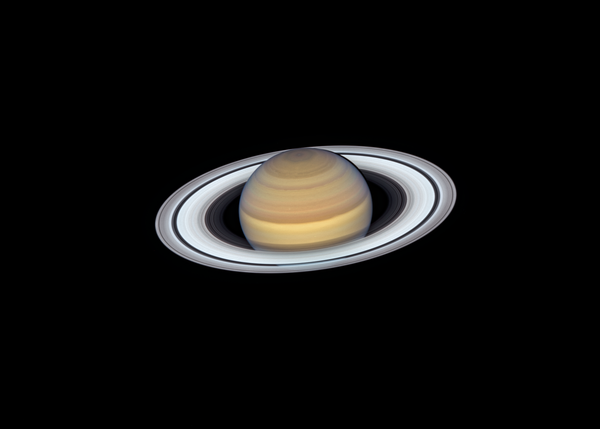The great Saturn ring debate is far from settled, a new study suggests.
For years, scientists have argued about the age of Saturn’s famous rings: Are they ancient, dating to the birth of the planet itself? Or did the ring system form more recently, in just the past hundred million years or so?
This latter hypothesis has been gaining steam in the last few years, with multiple papers reporting that the rings could be even younger than the dinosaurs. Such studies cite the rings’ composition—more than 95% pure water ice—and total mass, which NASA’s Cassini mission pegged at about 15.4 million billion metric tons shortly after the probe’s epic “grand finale” at Saturn in 2017. (For perspective, 15.4 million billion metric tons is about 40% the mass of the Saturn moon Mimas, which is 250 miles, or 400 kilometers, wide.)
On supporting science journalism
If you're enjoying this article, consider supporting our award-winning journalism by subscribing. By purchasing a subscription you are helping to ensure the future of impactful stories about the discoveries and ideas shaping our world today.
Given these two figures, and the bombardment rate by micrometeoroids, the rings must be young, the idea goes. After all, old rings should be much more “polluted” with silicates, organic molecules and other compounds.
But there are some serious issues with this interpretation, argues the new study, which was led by Aurélien Crida of the Université Côte d’Azur and the Institut Universitaire de France. For starters, the scientists said, the bombardment rate may vary over time. Maybe it’s unusually high right now—due to a (hypothetical) recent collision of distant Kuiper Belt objects, for example—and the rings were polluted much less intensely for most of their history.
Crida and his colleagues also note that, during the grand finale, Cassini spotted organics in Saturn’s upper atmosphere as well as solid grains in the gap between the gas giant and its innermost ring. This stuff is almost certainly coming from the rings, the researchers said.
“One possible explanation is that the (unknown) process responsible for the erosion of the rings and the launch of these nanograins is actually ’cleaning’ the rings, preferentially removing silicates rather than water ice,” Crida and his team wrote in the new study, which was published online today (Sept. 16) in the journal Nature Astronomy.
If that’s the case, the rings would appear to be much younger than they actually are.
Then there’s the ring system’s total mass. Indeed, 15.4 million billion metric tons “is actually consistent with the expected dynamical evolution of primordial, massive rings,” the researchers wrote in the new study. “Interactions between the ice blocks that constitute the rings lead to an outward transfer of angular momentum, resulting in the spreading of the rings.”
At distances greater than 87,000 miles (140,000 km) from Saturn, the ring material’s self-gravity trumps the gas giant’s tidal forces. This has led to the formation of moons and moonlets, and considerable mass loss from the rings, Crida and his colleagues said. The rings’ current mass, as measured by Cassini, fits well with an ancient origin followed by spreading and moon formation, they added (though the initial ring mass remains unknown).
Crida therefore thinks that Saturn’s rings are ancient—as old as the solar system.
“I have to admit that I am biased, because I like very much the model of satellite formation from rings (I contributed to develop it), and I would be annoyed if it [were] proven impossible,” he told Space.com via email.
“But I think that, objectively, it forms a much more consistent picture, with a convincing model of their formation at the same time as Saturn, plus formation and outward migration of the satellites in agreement with the observations,” he added. “In addition, the present mass is very consistent with 4.5 billion years of evolution, so that everything fits together.”
Nailing down the rings’ age is important for a variety of reasons, he and others have stressed. For starters, if the rings are young, then most of Saturn’s icy moons may be as well—including geyser-spewing Enceladus, which hosts a big ocean of salty water beneath its frigid shell.
Enceladus is widely viewed as one of the solar system’s best bets to harbor alien life, and the chances are much better in this regard if life has had 4.5 billion years to get going there rather than 100 million. (Another potentially life-hosting Saturn moon, the giant Titan, is widely regarded as ancient.)
In addition, a better understanding of the rings’ history would shed considerable light on the evolution of the Saturn system itself, Crida said. For example, were most of the planet’s moons indeed born from the rings, as the ring-spreading scenario posits?
“If the rings were born recently with their present mass, then this model cannot work, and the satellites must have formed differently (concurrently with Saturn, like the planets around the sun),” Crida told Space.com. “Also, this model of satellite formation from rings could apply to Uranus and Neptune (who would have then lost their original ring); hence, it is a more general issue than just Saturn.”
Researchers will keep poring over data from Cassini’s grand finale, and the many other measurements the spacecraft made during its 13-plus years at Saturn, for years to come. So, the debate over the age of Saturn’s rings will likely continue. Stay tuned!
Copyright 2019 SPACE.com, a Purch company. All rights reserved. This material may not be published, broadcast, rewritten or redistributed.
